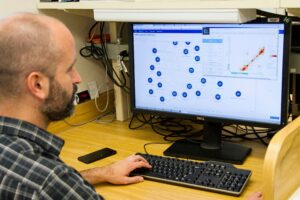
A Newcastle-led research team, supported by both national and international experts, is advancing its mission to develop a life-saving treatment for high-grade gliomas (HGG), the most aggressive and lethal form of brain cancer. This effort follows the announcement of an $18.7 million grant from the Australian Government.
Under the leadership of Professor Matt Dun from the University of Newcastle’s Hunter Medical Research Institute (HMRI) Precision Medicine Research Program, the team aims to test a suite of next-generation therapies. These therapies include drugs specifically designed to overcome the blood-brain barrier, with the goal of reaching clinical trials within five years. This development offers renewed hope to patients and families who currently have limited options.
Breakthrough in Brain Cancer Research
The $18.7 million grant is part of the Frontier Health and Medical Research initiative, funded by the Australian Government’s Medical Research Future Fund (MRFF). The initiative plans to allocate $700 million over a decade to support research that aims to create treatments for serious and currently incurable health conditions.
High-grade gliomas (HGG) are among the deadliest brain cancers, affecting over 2,000 Australians annually. In children, the most common form is diffuse intrinsic pontine glioma (DIPG), a devastating diagnosis with a survival rate of less than 12 months, even with radiotherapy. In adults, glioblastoma accounts for 65% of all brain cancer deaths and remains without effective treatment.
Challenges in Treating High-Grade Gliomas
- HGGs grow in sensitive brain areas, complicating surgical removal.
- Standard chemotherapies fail to penetrate the blood-brain barrier.
- The tumors possess complex genetic and immunological features, making them difficult to target.
Professor Dun and his team have identified a critical gene that drives the growth and survival of HGGs. Their research indicates that blocking this gene with new brain-penetrant drugs, especially when combined with radiotherapy and targeted therapy, can extend survival in preclinical models by more than 150%.
“Now, we’ve developed a suite of next-generation therapies designed specifically to reach the brain and target the tumor,” Professor Dun stated. “Our mission is to bring one of these new treatments to clinical trials within the next five years and bring hope to people who currently have no options.”
Personal and Professional Dedication
Despite decades of research, therapeutic progress in treating HGGs has been minimal, primarily due to the challenges of drug delivery to the brain and the complex biology of these tumors. Professor Dun’s research directly addresses these barriers by developing novel, brain-penetrant therapies targeting cancer dependencies.
In 2018, Professor Dun’s two-year-old daughter, Josephine, was diagnosed with DIPG. Through genetic sequencing of her tumor and extensive research, his team identified critical genes for DIPG survival and a combination of drugs to target the tumor. Josephine was the first child to receive a new therapy called paxalisib, which slowed the tumor’s growth and extended her life by a year.
“This grant holds particular significance for me, as it builds on the research we began in response to my daughter’s diagnosis,” Professor Dun said. “But it’s not just personal; it matters to everyone involved in changing the outlook for one of the most underfunded and devastating cancers globally.”
Collaborative Efforts and Future Prospects
University of Newcastle Vice-Chancellor, Professor Alex Zelinsky AO, expressed pride in leading the initiative. “The University of Newcastle is immensely proud to be leading this project, which epitomises the very best of university research – bold, collaborative, and focused on real-world outcomes for patients and families.”
The project is supported by a network of leading researchers, clinicians, and translational experts from institutions such as the University of New South Wales, Stanford University, University of Queensland, and others. This collaboration exemplifies “team science at its best,” according to Professor Dun.
“Neil Armstrong lost his daughter to DIPG over 60 years ago, before he walked on the moon,” Professor Dun remarked. “This grant helps bring brain cancer into focus, backing the science, the urgency, and the collective determination to make a difference.”
The research project underscores the University of Newcastle’s commitment to improving community health outcomes. Professor Dun, a National Health and Medical Research Council (NHMRC) Emerging Leadership Fellow, continues to lead efforts in pediatric brain cancer research, determined to transform the landscape of brain cancer treatment.





